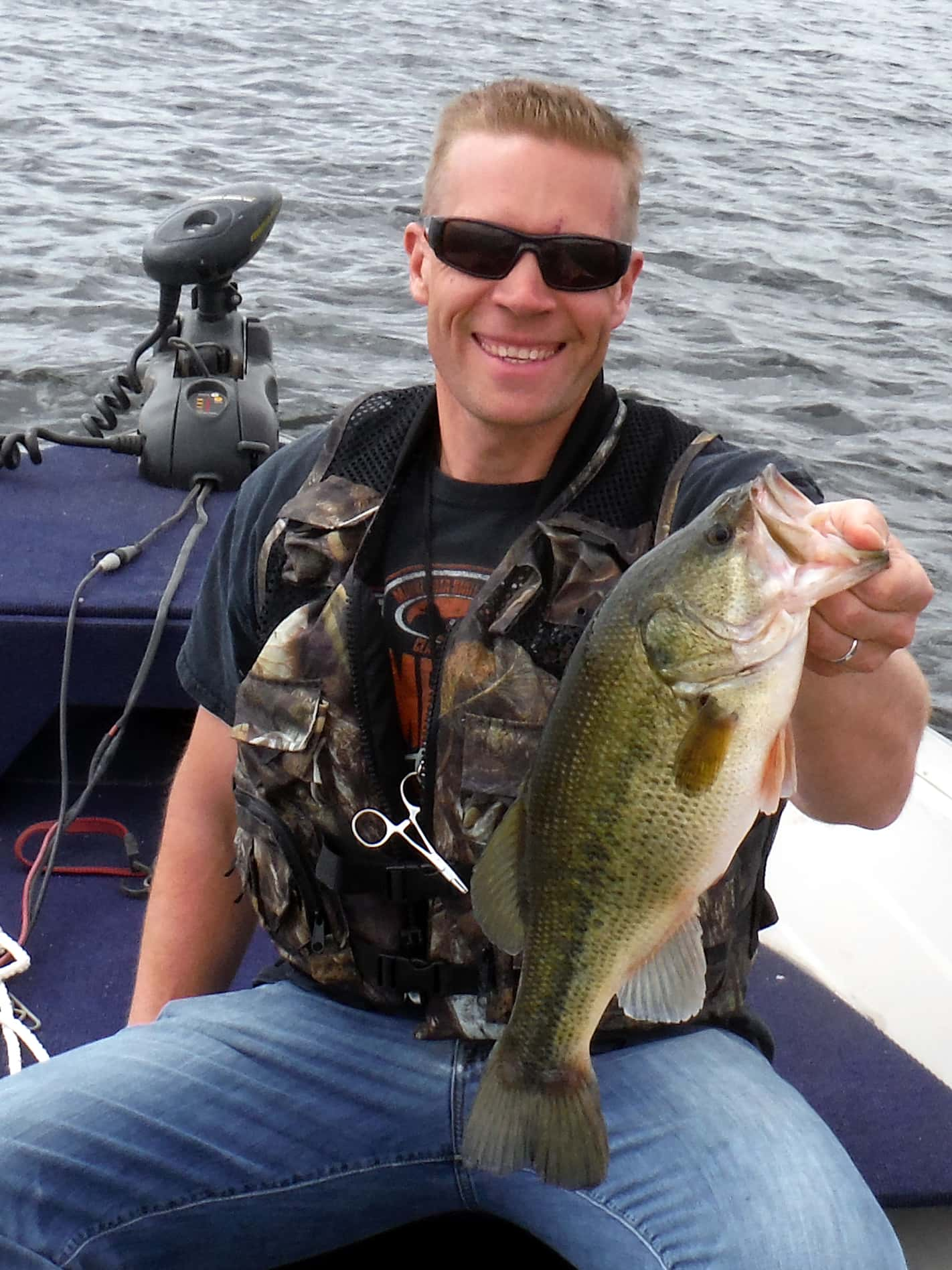
Take a Bow. The author with a nice largemouth caught from the bow of his Northwood boat, the “Puddle Jumper,” which has undergone a few makeovers since its purchase nearly a decade ago including from console to tiller.
By Nick Simonson
Wedged into the narrow corner under the removable jumpseat in the big boat which had just come out of storage this weekend, I struggled to aim my headlamp and balance the beam from my phone light at the connectors on top of the battery terminals, the snap of electric sulfur and scent of gear grease heavy in the transom compartment.
Unable to figure out why the hydraulic pump for the trim on the motor would not work when just the day before it had, it took me several attempts, before out of the corner of my eye, I caught a rogue wire dangling down into the darkness behind the battery. Reattaching the circle connector to the post and tightening down the wingut, I rejoiced as the system gave out a grindy whine with the motor in the full upright position, knowing I’d just saved myself another hundred-dollar trip to the shop.
Few statements regarding the outdoors are more accurate than “a boat is a hole in the water into which money is thrown.” Throughout my two decades of fishing, I’ve owned a few boats, and the seemingly genetic mechanical aptitude of my paternal grandfather appears to have been a recessive trait I did not inherit resulting in most of my watercraft making regular visits to the marina to keep them running. While they’ve all been hand-me-downs and holes of various depths, each requiring their own share of TLC to not only get them seaworthy from season-to-season, but also when getting significant makeovers as my location and uses for them changes.
My first boat, received when I was fresh out of college was a gift from my parents, a 15-foot flat-bottomed Grumman Sportsman with a 35-horse Johnson motor that I picked up from a guy in Rugby, N.D. Driving up in a downpour with a buddy from my home in Valley City during one of the most memorable spring cold fronts I had ever lived through (the system looked like a landlocked hurricane, which actually moved backwards on day five and six), we tracked the boat down and I pulled the trigger, filling in the blanks on the check with my dad’s signature already written in. It caught countless fish, and plowed its way through the occasional whitecap, soaking my buddy and I on the regular when conditions weren’t ideal. As a river craft though, it was nigh unstoppable, getting into skinny water and tucking right up to structure, catching smallies and walleyes and every other species we pursued like a gem, even if its hull became permanently stained brown with the water of the Sheyenne River.
While the Grumman never had any significant breakdowns, it required a couple tweaks to the motor when a pin would get loose and the shifter would slip, leaving the motor stuck in neutral a couple of times each summer. After four or five trips to the shop, the owner pulled me aside as I picked up the boat and he popped the cover off the motor. He pointed to the pin and showed me the five-second fix to the problem, perhaps as a reward for being such a reliable customer, though undoubtedly cutting into what had become regular business. When I moved away and got married, I left the Grumman in the care of my brother and it still runs from time to time when he finds a hot bite, albeit with a newer Johnson on its transom.
My next boat was a Northwood 1675, which at the outset was a disaster. The Force-brand motor, after I had done some internet research following my purchase, was prone to all sorts of issues. After being told by one marina in northern Minnesota – which shortly thereafter went out of business, not surprisingly – that “everything was fine” while handing me a $125 bill, I turned it over to one of my more mechanically inclined friends who said that each cylinder in the engine was damaged and its primary value would be as a cadaver for scientific study in his small engine repair class. I sold it to his tech school in Detroit Lakes for a few hundred bucks and found a used Mercury tiller that I dropped onto the transom.
Since then, that old Merc has performed up to its godlike name. Fast, reliable and easily stashed in the garage for the winter, it turns over each spring with a little tweaking of the choke and needs only a cleaning of the carburetor and a shot of SeaFoam from time-to-time, but has been the least needy of all the motors I’ve owned. Well worn and showing some bald spots where the marine carpet is giving way on the main deck, an updated bow casting stand created by my carpenter cousin has made the boat an ideal small water craft and for fly fishing trout, crappies and bass, and it has become a reliable platform without being too holey in nature, at least in the last few seasons.
I’ve dumped money on the engine of my big boat – an old Lund 1850 – to watch it go up in a puff of smoke and sunk hundreds of dollars into turning it into a salmon rig for Lake Sakakawea. It’s caught two chinooks thus far, averaging out to around right around $128 per pound, but there’s always hope that the price will drop this summer! I had the same friend who diagnosed the forceless Force engine rebuild the power source on my grandmother’s party boat and I even converted the busted bench seat in the back of my parents’ Dolphin Princess canoe into a cooler/livewell (all depending on the day and how fast the fishing is) and made countless wiring repairs, seat placement tweaks and adjustments of lighting and other accessories on all of my crafts with what little skill in those areas I have been cursed with.
I’ve seen my share of holes in the water and have done my very best to fill them with the money I’ve had available in various phases of life as I’m sure most anglers do, knowing that’s often the price of getting from the launch to the latest hotspot and remains the cost of doing business…in our outdoors.

